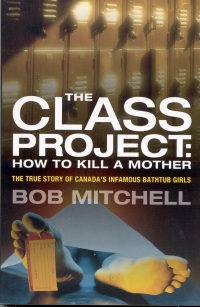| ________________
CM . . .
. Volume XV Number 10. . . .January 9, 2009 
 |
The Class Project: How to Kill a Mother: The True Story of Canada's Infamous Bathtub Girls.
Bob Mitchell.
Toronto, ON: Key Porter Books, 2008.
356 pp., pbk., $22.95.
ISBN 978-1-55263-929-0.
Subject Headings:
Parricide-Ontario-Mississauga.
Juvenile homicide–Ontario-Mississauga.
Grades 9 and up / Ages 14 and up.
Review by Thomas F. Chambers.
** /4
|
| |
|

excerpt:
"Well, all I had to do was hold her head under water," Sandra said. "She was in a bathtub filled with water. It's not hard. It's a lot easier to kill a person than you think. I don't know how easy it is to get away with it. But I planned it pretty well. And like there's all this stuff you have to remember. Like when you're giving your statement to the cops or whatever. You have to remember, like, you know things that people do when they're lying. Like, start off with something big, and then get more and more into details. Like, that's obviously a major sign that you're lying."
The Class Project is a story so evil it is difficult to accept that it is real. That two teenage girls could deliberately murder their mother, with the full knowledge of friends, sounds like a work of fiction, not reality. Because The Class Project is a true story, it becomes more fascinating than a comparable work of fiction. There is so much horror and brutality in the world that we often pay little attention to "just another murder." But this murder was so unusual and incomprehensible; it captured the attention of Canadians.
The names of the killers (Sandra and Beth in the book) were changed, as was that of their family members and close friends, to protect the girls' identities. Apart from their names, those of all others mentioned are real. Had Sandra and Beth been adults their names might have become as infamous as that of Paul Bernardo. A few facts have also been changed to keep the girls' names secret, but, in essence, The Class Project is a true story.
Sandra and Beth lived in Brampton, ON, with their mother Linda, an alcoholic, and younger brother Bobby. Linda's behaviour was a constant embarrassment to the girls, so much so that in January 2003, after Linda had taken a number of Tylenol-3s and become drunk, the girls put her in the bathtub and drowned her. The murder had been well-planned in advance and known by three of their closest friends. The killing remained a secret for a year until Sandra began talking about what they had done.
In the Foreword, it states that 'prior to killing their mom, the eldest girl told just about everyone in their social group that she and her younger sister were plotting the crime." This is quite misleading because, apart from the two sisters, only three of their friends knew about the intended murder. The girls' "social group" or "class" was, therefore, very small, and the book's title an exaggeration.
While the story of the killing is horrific, the many details about the daily life of the family (drunken mother, two self centered girls and a young brother who is rarely mentioned) are boring. How exciting can numerous tales of a drunken mother be? What is interesting about two pot smoking girls fantasizing about how good the future would be without their mother? Their life experiences were so ordinary and dull that reading about them is not pleasant and certainly not exciting. While teenagers might be intrigued by the story, they are likely to become bored long before they finish the book.
There are two parts to The Class Project. The first deals with the murder and the life lived by the two girls. The second, and more interesting, discusses the police procedure after the girls' arrest and their subsequent trial.
Author Bob Mitchell, a reporter with The Toronto Star, specializes in crime and the justice system. He used his considerable reporting skills to uncover the facts of the story from court transcripts of the trial, audiotapes of police interviews and video recordings. Extensive use was also made of conversations conducted over chat lines. The result of all his research, however, is that there are too many facts, too many petty details.
The Class Project could be used for recreational purposes. It has no index or teaching aids, and, of course, no photographs. It is well written in an easily readable style.
Recommended.
Thomas F. Chambers, a retired college professor, lives in North Bay, ON.

To comment
on this title or this review, send mail to cm@umanitoba.ca.
Copyright © the Manitoba Library Association. Reproduction for personal
use is permitted only if this copyright notice is maintained. Any
other reproduction is prohibited without permission.
NEXT REVIEW |
TABLE OF CONTENTS FOR THIS ISSUE
- January 9, 2009.
AUTHORS |
TITLES |
MEDIA REVIEWS |
PROFILES |
BACK ISSUES |
SEARCH |
CMARCHIVE |
HOME |
